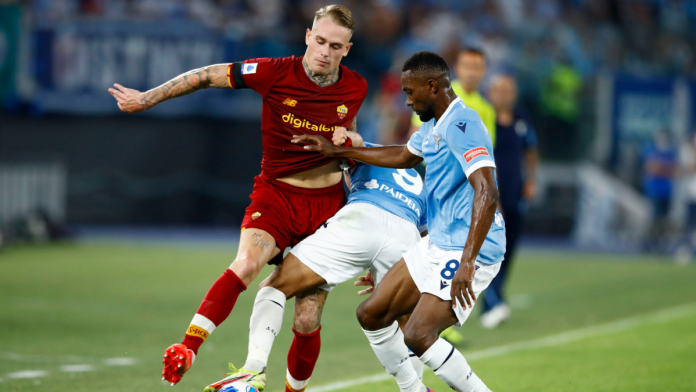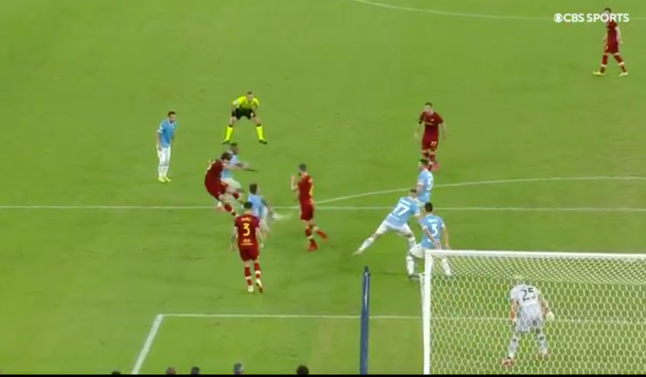
The major clash between Lazio Roma on Matchday 6 in Serie A on Sunday did not disappoint. From a referee’s perspective, however, there were three critical plays in the game (a 3-2 Lazio win) that challenged the referee team, so let’s take a deeper dive as to why the decisions were made.
Not a stranger to the Derby and in his 11th year as a center official in Serie A, center FIFA Official and Italian referee Marco Guida, took charge of this anticipated matchup with assistance from one of the best video assistant referees in the world, Italian VAR Massimiliano Irrati.
And these two had their hands full with three penalty decisions in the 19th minute (penalty not given for Roma), 23rd minute (penalty not given for Lazio), and the 67th minute (penalty given for Roma).
In the 19th minute, we find a cross onto the top of the penalty area in the direction of Roma’s Zaniolo, who was contacted by Lazio’s Hysaj while challenging for the ball. Guida and his assistant referee Giorgio Peretti deemed it not worthy of a penalty and the play resulted in a quick counterattack by Lazio and a second goal by Pedro.
The correct decision is “no penalty” and was given by Guida. Is there contact by Hysaj on Zaniolo? Yes, no one is denying that but it is expected normal contact in the context of this play where Zaniolo feels the contact and goes down easily knowing his placement in the penalty area. This is an example officials are shown to demonstrate the level of contact that is expected and does not rise to the level of a penalty. It is also important to note that the VAR, Irrati, would have first checked this play to determine whether there is a clear and obvious error to overturn the no penalty decision and as a result negate the goal. It was a “check complete” (meaning no on-field recommendation to be given) from a VAR perspective and the correct decision.
Similar to Zaniolo’s no penalty decision is the decision in the 23rd minute between Lazio’s Felipe Anderson and Roma’s Roger Ibanez. Anderson tries to get around Ibanez and penetrates into the right side of the penalty area. Guida is perfectly placed as to angle and proximity and is supported by assistant referee Filippo Meli who also has a good angle and distance to gauge the level of contact.
Craving even more coverage of the world’s game? Listen below and follow ¡Qué Golazo! A Daily CBS Soccer Podcast where we take you beyond the pitch and around the globe for commentary, previews, recaps and more.
The correct decision is “no penalty.” Once again, there is contact and more upper body than lower body, but this is expected normal contact when you have two players equally challenging for the ball and position on a 1-on-1 matchup where the next play would be either continuation to the goal or a slot across by Anderson to a teammate streaking down the mouth of the goal. There’s a lot on the line for both attacker and defender and as such the contact will be more in the fight to win this challenge. Another example where this play would demonstrate to officials the level of contact expected and does not rise to a penalty given.
Now for the one that challenges high-level football understanding: the penalty given to Roma in the 67th minute because of the contact made on the right leg of Lazio’s Jean-Daniel Akpa Akpro by the left striking foot of Roma’s Nicolo Zaniolo. This call is entirely in the decision of Guida as it is a “referees call only” meaning his assistant referees do not have a better angle or proximity than his to provide further information. Guida was on the top of the penalty area, with a completely zeroed-in, focused view of the play and confidence in his decision.
This one will be up for debate but the preferred decision is “no penalty” because Alpa Akpro did not make a secondary movement or put himself in the path of Zaniolo’s strike on the ball, which is the critical distinction.
These kinds of plays are hotly debated in post-game referee education because it is heavily fact-specific and several angles can show a picture that makes you question another angle you were previously shown. The overall question we ask ourselves in these kinds of plays is “Did the attacker kick the defender or did the defender put him/herself into the line or path of the attacker?”
If the defender is determined by the overall weight of the evidence to have put him/herself in the line or path in the context of that specific play, then it is more likely a penalty or direct free kick. So with that frame of mind, in analyzing this play, there is an expectation that when an attacker is about to strike the ball onto the goal they will naturally have to move their leg farther up and with quick momentum forward. This time frame can give a defender just enough time to step into that space of the attacker’s shooting space in an attempt to prevent the shot completely and appear like a foul in favor of the defender.
Here, based on the angles available, it appears to lean more toward Zaniolo making the contact towards Alpa Akrpo, who was naturally running into that direction but not into the space of the kick. Zaniolo instead initiated the contact with no secondary action by Alpa Akrpo and for those reasons I lean toward a preferred decision of no penalty.
I can see how a decision for a penalty could be argued and why the referee did call a penalty but ultimately we need a final answer and based on the ability to break down this play in the comforts behind several camera angles and no time pressure, my decision is no penalty.
As for Irratti, it was appropriate for him to check and determine it was a “Check Complete” because either he determined the angles were inconclusive or not enough to overturn the referee’s decision as you can see contact on Alpa Akrpo’s leg with Zaniolo’s foot and therefore it was not a “clear and obvious error.” Instead, this comes down to a judgment call where VAR protocols defer to the official’s call on the field to be the final decision.
In the referee world, we want penalties to be “clean” because the gravity of the decision in giving a penalty is a high probability in a goal. The sanction must fit the action and be a call the football world understands and accepts. The first two calls the collective football world accepts as no penalty, the third call the football world understandably struggles as to why it’s a penalty because Akpa Akpro did nothing to step into the kicking range, and based on this action it doesn’t justify the impact a penalty kick can have on this game.
You can watch every Serie A match this season on Paramount+.






